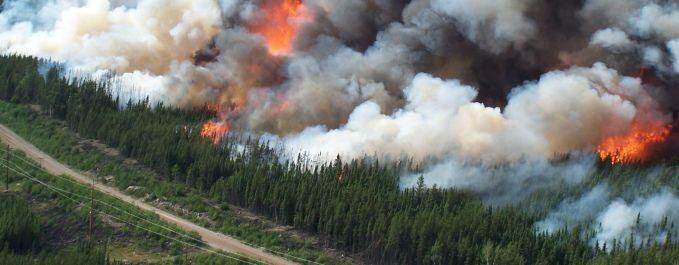
Why we measure this
Natural disturbances such as fire, wind, flood, insects and disease outbreaks are an important part of the natural life cycle of forests, especially the boreal forest. These disturbances change the environment by changing the amount and distribution of forest stand types across the landscape, diversify the age class distribution of forest stands and facilitate the renewal of the forest.
All natural disturbance types are unpredictable and can have a significant effect on sustainable forest management. While natural disturbances are essential to forest health and renewal, they can have a negative impact on communities and businesses that reside in or rely on forests. Wildfires threaten human safety, property and infrastructure, and smoke often becomes a public health concern. All natural disturbances can damage and reduce the supply of timber and impact the socio-economic well-being of communities and citizens.
What is happening

Although these disturbances are natural forces shaping the boreal forest, there is a need to maintain and protect forests and other values found within the forest. There is a cost to deploying resources to protect the forest from wildfire, insects and disease, and there is a cost to lost timber for forest products. Unpredictable disturbances create uncertainties in terms of forest product availability, and can have a significant effect on sustainable forest management.
The provincial forest management planning standard requires the owner of a forest management plan to describe how the risks of natural disturbances including fire, insects, disease and wind could affect the timber supply. Forest management plans must be revisited when the projected sustainable timber targets and other management objectives over the planning period are no longer achievable due to natural disturbance.
Spruce budworm, jack pine budworm, forest tent caterpillar and large aspen tortrix are all cyclic in their outbreak behaviour. Generally, populations of these insects increase and reach outbreak levels within expected and predictable timeframes. These pests feed on tree foliage and may cause tree mortality after repeated annual attacks during outbreaks.
The spruce budworm cycle is relatively long, and peak outbreaks are expected to occur roughly 35 years apart. A spruce budworm outbreak that peaked in 2002 poses no current threat to sustainable forest management.
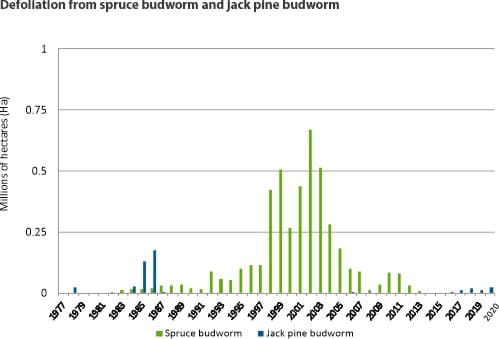
Hardwood defoliation is primarily caused by forest tent caterpillar cycles approximately every 10 to 12 years, with outbreaks lasting three to five years. The pattern has been quite regular with outbreaks occurring in 2001 to 2007 and again from 2013 to 2017. The outbreak in the early 2000s was not aerially mapped (and does not appear on the graph below); however, disturbed areas are documented in a separate report produced by BioForest Technologies in 2015. The current outbreak that reached a peak in 2017 has now generally collapsed throughout the province.

Along with fire, insect and disease disturbances, physical (abiotic) disturbances including drought, flooding and extreme wind events result in tree mortality, which leads to stand-level and landscape-level changes in the forest ecosystem. Abiotic disturbances shape forest structure, composition and function, and contribute to maintaining a biologically diverse and healthy forest. It is only more recently that abiotic disturbances are being monitored at the same time as the insect and disease aerial survey. Events such as blowdown and flooding are the more prevalent cause of abiotic disturbances.
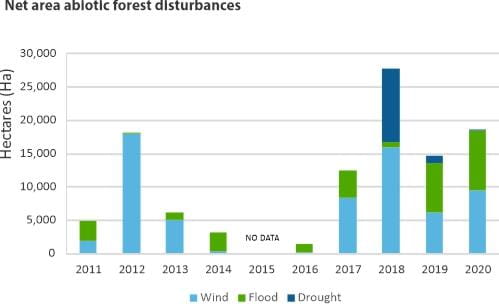
The boreal forest ecosystem is driven by natural disturbances. Boreal species have evolved over time to cope with, and even require, periodic disturbance as part of their natural life cycles. Wildfires are a natural part of the forest ecosystem. The area burned from year to year varies and is significantly affected by weather. Autumn and spring rains, timely summer precipitation, and winter snowfall will significantly reduce wildfires and limit their spread.
While the number and size of catastrophic wildfires in some North American jurisdictions has increased over the last five years, 20 years of available data do not show any statistically significant increasing trend in Saskatchewan. However, some variation is occurring in the expected seasonal trends during a wildfire season. Climate change is expected to extend wildfire seasons with potentially more extreme weather events occurring within a wildfire season that could support more severe wildfires.
The Government of Saskatchewan uses modern technology and decision-making systems to detect, monitor and suppress wildfires, and has dedicated resources to help promote FireSmart principles. Wildfires that threaten human life and communities are always the government's top priority, followed by protection of critical public infrastructure, major industrial infrastructure, commercial timber, remote structures and natural resources. Wildfires in low-value timber areas and non-commercial northern forests are considered for initial attack and sustained action based on an assessment of values and estimated financial cost. Some wildfires are allowed to act as a necessary and natural process on the landscape.
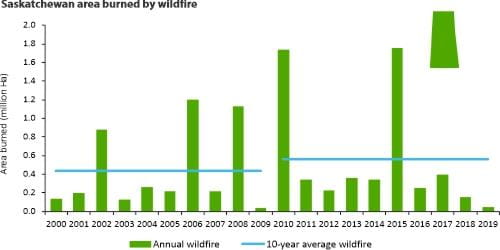
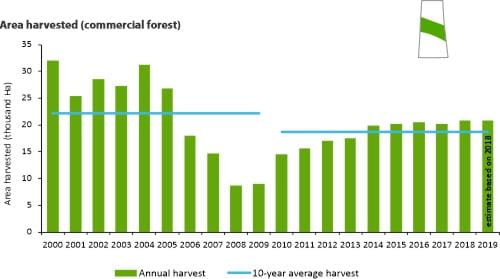
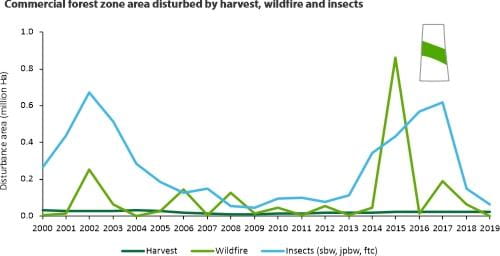
What we are doing
Disturbances influence forest structure, composition and function and are important in maintaining biological diversity, forest dynamics and regeneration. Sustainable forest management is successful when management strategies emulate natural processes. The ministry conducts annual aerial surveys to monitor insects, diseases and weather events that cause major forest disturbances to assess the health of Saskatchewan's forest.
The three main natural native insect disturbance agents tracked by aerial survey across the commercial forest and select provincial parks* are spruce budworm, jack pine budworm and forest tent caterpillar. Other damaging agents monitored during the annual aerial surveys include:
- eastern larch beetle;
- spruce beetle;
- aspen leaf spot disease;
- large aspen tortrix
- spruce needle rust; and
- abiotic damage from wind, floods and drought.
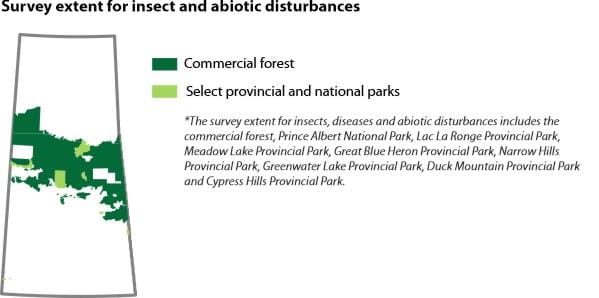
Forest harvesting for commercial timber products is a human disturbance impacting an average of 18,700 hectares per year between 2010 and 2019. This represents roughly a quarter of one per cent (0.24 per cent) of forested lands within Saskatchewan's commercial forest zone. Forest managers work to ensure timber harvesting resembles natural forest disturbance patterns. In the commercial forest zone, wildfires are the second-largest disturbance type, with approximately 127,060 hectares burned per year on average between 2010-2019. The largest disturbance type in the commercial forest zone are insects and diseases. In the case of the three most impactful forest defoliating insect pests (spruce budworm, jack pine budworm, and forest tent caterpillar), 255,260 hectares per year on average were disturbed between 2010-2019. While insects and diseases cause the greatest disturbance in terms of area in the commercial forest zone, it should be noted that they generally do not result in immediate stand replacing events, such is often the case for wildfire and timber harvesting.









